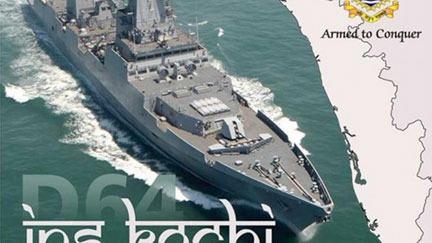India's growing influence and ambition
by Sylvia Mishra
China's growing naval presence in the Indian Ocean and assertiveness
in maritime territorial disputes in East and South China Sea has once
again heightened discussion about an enhanced role for India in the
Asia-Pacific. The region is witnessing a strategic flux as both the
Asian giants, India and China, leave footprints in each other's
backyards the Indian Ocean and Asia-Pacific region respectively.
 |
|
Indian Navy Ship INS Kochi
during sea trials.
Photo: IDRW, WIkipedia Commons |
These developments come at a time when the United States is
rebalancing towards Asia; Japan under Prime Minister Abe is modifying
its post-war pacifist constitution; and most of Southeast Asia's
countries are increasingly looking towards India to become a credible
counter-weight to balance China. Several Asia-Pacific countries have
cast doubts on China's so-called 'peaceful rise', and there is a growing
dependence on the security umbrella provided by the United States. This
delicate security fabric in the region is further exacerbated by the
lack of existing security architecture.
India's Foreign Secretary, Subrahmanyam Jaishankar, recently claimed
that India is transitioning from being a balancing power to a leading
power. If that's true, it is imperative that India undertakes more
responsibilities in the region.
Yet despite steps by successive Indian Governments to direct its
foreign, economic and military strategies eastward, India has been
unable to deeply integrate itself in the Asia-Pacific like the United
States or China. So far India's role in the region has been limited -
reactive and at best episodic - even though it has the desire and the
potential to become an important actor and help shape the future
security architecture in the region.
If the shifting balance of power in the Asia-Pacific is shaping
India's political goals there, India too is shaping the region by
developing its own comprehensive national power, active blue water navy
diplomacy, and collaborating with regional powers like Japan and
Australia. India figures prominently in US geostrategic security
thinking, and the global security interests of both countries have found
maximum convergence in the Asia-Pacific region.
India's defence and security cooperation with the US is also growing.
The United States is India's largest defence supplier and both countries
are engaging in expanded military exercises. During the visit of India's
Defence Minister Manohar Parrikarto the Pentagon, US Defence Secretary
Ashton Carter said, "The defence partnership between the United States
and India will become an anchor of global security." These are signs
that the region can expect India and the US to work to secure a stable
Asia-Pacific without being dominated by China.
India-US collaborative partnership in the Asia-Pacific region is
aimed at accommodating China in a security order which is inclusive and
rules-based. Both countries are also determined to retain the status quo
in the region, and hedge against a China which is increasingly
unilateral and assertive in its actions.
But in spite of overlapping strategic interests, Indian security
planners have genuine concerns regarding US-China relations. Several
commentators have highlighted the uncertainty of the future course of
relations between Washington and Beijing, fearing a G-2 which could lead
to power-sharing in the region.
To become a regional power, India has been gradually building its
defence and security relationships with a number of Southeast Asian
nations. Over the past decade, India has expanded its naval presence
into the South China Sea and exercised with Southeast Asian navies,
particularly Singapore, Malaysia, Indonesia, Thailand, Vietnam, and the
Philippines.
However, India and some of the ASEAN states believe that India should
play a still greater diplomatic and security role in the region. This
could include a larger naval presence with a force capable of operating
in open seas and projecting power to areas of strategic interest. New
Delhi particularly targets a strong presence in the
strategically-located Malacca Straits, which accounts for 40 per cent of
the world's trade and more than 80 per cent of China's oil imports.
However, India's long-held desire for a blue-water Navy has met with
stuttering progress in recent years; the Indian navy has seen a
reduction in its allocated budget from 19 per cent in 2012 to 2013 to 16
per cent in 2015-2016.
For Indian policymakers in the security arena, the challenge in
building India as a key Asia-Pacific actor will boil down to four
elements: willingness to project and sustain its military presence
beyond the Indian Ocean; India's ability to put concerted focus on
Asia-Pacific, moving away from its obsession with Pakistan; New Delhi's
capability to break the gridlock of a defensive mindset of hedging
against China and finally, India's resolve to deepen its economic
cooperation with Southeast Asian countries.
India's security role in the Pacific will be critical in sustaining
and maximizing its strategic interests in the Indian Ocean. As
competition for strategic space continues to rise in the Indian Ocean,
New Delhi must continue to build its partnership with the US, Southeast
Asian states and the regional powers. This will be instrumental in
positioning India as a credible security provider in the region.
-Observer Research Foundation |

